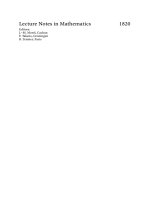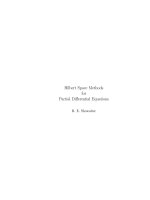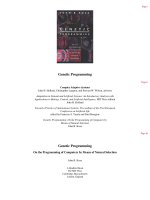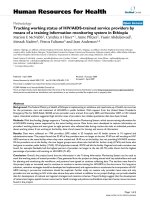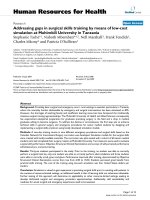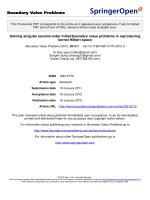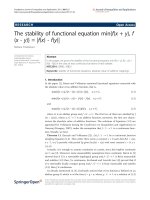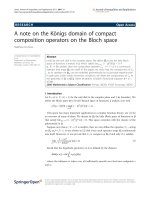means of hilbert space operators - f. hiai, h. kosaki
Bạn đang xem bản rút gọn của tài liệu. Xem và tải ngay bản đầy đủ của tài liệu tại đây (2.71 MB, 150 trang )
Lecture Notes in Mathematics 1820
Editors:
J M. Morel, Cachan
F. Takens, Groningen
B. Teissier, Paris
3
Berlin
Heidelberg
New York
Hong Kong
London
Milan
Paris
Tokyo
Fumio Hiai
Hideki Kosaki
Means of
Hilbert Space Operators
13
Authors
Fumio Hiai
Graduate School of Information Sciences
Tohoku University
Aoba-ku, Sendai
980-8579 Japan
e-mail:
Hideki Kosaki
Graduate School of Mathematics
Kyushu University
Higashi-ku, Fukuoka
812-8581 Japan
e-mail:
Cataloging-in-Publication Data applied for
Bibliographic information published by Die Deutsche Bibliothek
Die Deutsche Bibliothek lists this publication in the Deutsche Nationalbibliografie;
detailed bibliographic data is available in the Internet at
Mathematics Subject Classification (2000): 47A30, 47A64, 15A60
ISSN 0075-8434
ISBN 3-540-40680-8 Springer-Verlag Berlin Heidelb erg New York
This work is subject to copyright. All rights are reserved, whether the whole or part of the material is
concerned, specifically the rights of translation, reprinting, reuse of illustrations, recitation, broadcasting,
reproductiononmicrofilmorinanyotherway,andstorageindatabanks.Duplicationofthispublication
orpartsthereofispermittedonlyundertheprovisionsoftheGermanCopyrightLawofSeptember9, 1965,
in its current version, and permission for use must always be obtained from Springer-Verlag. Violations are
liable for prosecution under the German Copyright Law.
Springer-Verlag Berlin Heidelberg New York a member of BertelsmannSpringer
Science + Business Media GmbH
c
Springer-Verlag Berlin He idelberg 2003
PrintedinGermany
The use of general descriptive names, registered names, trademarks, etc. in this publication does not imply,
even in the absence of a specific statement, that such names are exempt from the relevant protective laws
and regulations and therefore free for general use.
Typesetting: Camera-ready T
E
Xoutputbytheauthor
SPIN: 10949634 41/3142/ du - 543210 - Printed on acid-free paper
Preface
Roughly speaking two kinds of operator and/or matrix inequalities are known,
of course with many important exceptions. Operators admit several natural
notions of orders (such as positive semidefiniteness order, some majorization
orders and so on) due to their non-commutativity, and some operator in-
equalities clarify these order relations. There is also another kind of operator
inequalities comparing or estimating various quantities (such as norms, traces,
determinants and so on) naturally attached to operators.
Both kinds are of fundamental importance in many branches of math-
ematical analysis, but are also sometimes highly non-trivial because of the
non-commutativity of the operators involved. This monograph is mainly de-
voted to means of Hilbert space operators and their general properties with
the main emphasis o n their norm comparison results. Therefore, our o perator
inequalities here are basically of the second kind. However, they are not free
from the first in the sense that our general theor y on means relies heavily on
a certain order for operators (i.e., a majorization technique which is relevant
for dealing with unitarily invariant norms).
In recent years many norm inequalities on operator means have been in-
vestigated. We develop here a general theory which enables us to treat them in
a unified and a xiomatic fa shion. More precisely, we associate operator means
to give n scalar means by making use of the theory of Stieltjes double integral
transformations. Here, Peller’s characterization of Schur multipliers plays an
important role, and indeed guarantees that our operator means are bounded
operators. Basic properties on these operator means (such as the convergence
property and norm bounds) are studied. We also obtain a handy criterion (in
terms of the Fourier transformation) to check the validity of norm comparison
among op erator means.
Sendai, June 2003 Fumio Hiai
Fukuoka, June 2003 Hideki Kosaki
Contents
1 Introduction 1
2 Double integral transformations 7
2.1 SchurmultipliersandPeller’stheorem 8
2.2 Extension to B(H) 18
2.3 Normestimates 21
2.4 Technicalresults 24
2.5 Notes and references . . . . . . . . . . . . . . . . . . . . . . . . . . . . . . . . . . . . . 31
3 Means of operators and their comparison 33
3.1 Symmetrichomogeneousmeans 33
3.2 Integralexpressionandcomparisonofnorms 37
3.3 Schurmultipliersformatrices 40
3.4 Positivedefinitekernels 45
3.5 Normestimatesformeans 46
3.6 Kernel and range of M(H, K ) 49
3.7 Notes and references . . . . . . . . . . . . . . . . . . . . . . . . . . . . . . . . . . . . . 53
4 Convergence of means 57
4.1 Main conver gence result . . . . . . . . . . . . . . . . . . . . . . . . . . . . . . . . . . 57
4.2 Related convergence results . . . . . . . . . . . . . . . . . . . . . . . . . . . . . . . 61
5 A-L-G interpolation means M
α
65
5.1 Monotonicityandrelatedresults 65
5.2 Characterization of |||M
∞
(H, K)X||| < ∞ 69
5.3 Normcontinuityinparameter 70
5.4 Notes and references . . . . . . . . . . . . . . . . . . . . . . . . . . . . . . . . . . . . . 78
6 Heinz-type means A
α
79
6.1 Normcontinuityinparameter 79
6.2 Convergence of operator Riemann sums . . . . . . . . . . . . . . . . . . . . 81
VIII Contents
6.3 Notes and references . . . . . . . . . . . . . . . . . . . . . . . . . . . . . . . . . . . . . 85
7 Binomial means B
α
89
7.1 Majorization B
α
M
∞
89
7.2 Equivalence of |||B
α
(H, K)X||| for α>0 93
7.3 Normcontinuityinparameter 96
7.4 Notes and references . . . . . . . . . . . . . . . . . . . . . . . . . . . . . . . . . . . . . 103
8 Certain alternating sums of operators 105
8.1 Preliminaries 106
8.2 Uniform bounds for norms . . . . . . . . . . . . . . . . . . . . . . . . . . . . . . . . 110
8.3 Monotonicityofnorms 117
8.4 Notes and references . . . . . . . . . . . . . . . . . . . . . . . . . . . . . . . . . . . . . 120
A Appendices 123
A.1 Non-symmetricmeans 123
A.2 Norminequalityforoperatorintegrals 127
A.3 Decomposition of max{s, t} 131
A.4 Ces`arolimitoftheFouriertransform 136
A.5 Reflexivity and separability of operato r idea ls . . . . . . . . . . . . . . . 137
A.6 Fourier transform of 1/cosh
α
(t) 138
References 141
Index 145
1
Introduction
The present monograph is devoted to a thorough study of means for Hilbert
space operators, especially comparison of (unitarily invariant) norms of oper-
ator means and their convergence properties in various aspects.
The Hadamard product (or Schur product) A ◦ B of two matrices A =
[a
ij
],B=[b
ij
] means their entry-wise product [a
ij
b
ij
]. This notion is a com-
mon and powerful technique in investigation of general matrix (and/or opera-
tor) norm inequalities, and particularly so in that of perturbation inequalities
and commutator estimates. Assume that n × n matrices H, K, X ∈ M
n
(C)
are given with H, K ≥ 0 and diagonalizations
H = Udiag(s
1
,s
2
, ,s
n
)U
∗
and K = V diag(t
1
,t
2
, ,t
n
)V
∗
.
In our previous work [39], to a given scalar mean M(s, t)(fors, t ∈ R
+
), we
associated the corresponding matrix mean M(H, K)X by
M(H, K)X = U ([M(s
i
,t
j
)] ◦ (U
∗
XV )) V
∗
. (1.1)
For a scalar mean M(s, t)oftheform
n
i=1
f
i
(s)g
i
(t) one easily observes
M(H, K)X =
n
i=1
f
i
(H)Xg
i
(K), and we note that this expression makes
a perfect sense even for Hilbert space operators H, K,X with H,K ≥ 0.
However, for the definition of general matrix means M(H, K)X (such as A-
L-G interpolation means M
α
(H, K)X and binomial means B
α
(H, K)X to
be explained later) the use of Hadamard products or something alike seems
unavoidable.
The first main purpose of the present monograph is to develop a reason-
able theory of means for Hilbert space operators, which works equally well
for general scalar means (including M
α
, B
α
and so on). Here two difficul-
ties have to be resolved: (i) Given (infinite-dimensional) diagonal operators
H, K ≥ 0, the definition (1.1) remains legitimate for X ∈C
2
(H), the Hilbert-
Schmidt class operators on a Hilbert space H,aslongasentriesM(s
i
,t
j
)
stay bounded (and M(H, K )X ∈C
2
(H)). However, what we want is a mean
M(H, K)X (∈ B(H)) for each bounded operator X ∈ B(H). (ii) General
F. Hiai and H. Kosaki: LNM 1820, pp. 1–6, 2003.
c
Springer-Verlag Berlin Heidelberg 2003
2 1 Introduction
positive op erators H, K are no longer diagonal so that continuous spectral
decomposition has to be used. The requirement in (i) says that the concept
of a Schur multiplier ([31, 32, 66]) has to enter our picture, and hence what
we need is a continuous analogue of the operation (1.1) with this concept
built in. The theory of (Stieltjes) double integral transformations ([14]) due
to M. Sh. Birman, M. Z. Solomyak and others is suited for this purpose. With
this apparatus the operator mean M(H, K )X is defined (in Chapter 3) as
M(H, K)X =
H
0
K
0
M(s, t) dE
s
XdF
t
(1.2)
with the s pectral decompositions
H =
H
0
sdE
s
and K =
K
0
tdF
t
.
Double integral transformations as above were actually considered with
general functions M (s, t) (which are not necessarily means). This subject has
important applications to theories of perturbation, Volterra operators, Hankel
operators and so on (see §2.5 for more information including references), and
one of central problems here (besides the justification of the double integral
(1.2)) is to determine for which unitarily invariant norm the transformation
X → M(H, K )X is bounded. Extensive study has been made in this direc-
tion, and V. V. Peller’s work ([69, 70]) deserves special mentioning. Namely,
he completely characterized ( C
1
-)Schur multipliers in this setting (i.e., bound-
edness criterion relative to the trace norm ·
1
, or equivalently, the operator
norm · by the duality), which is a continuous counterpart of U. Haagerup’s
characterization ([31, 32]) in the matrix setting. Our theory of operator means
is built upon V. V. Peller’s characterization (Theorem 2.2) although just an
easy part is needed. Unfortunately, his work [69] with a proof (while [70] is
an announcement) was not widely circulated, and details of some parts were
omitted. Moreover, quite a few references there are not easily accessible. For
these reasons and to make the monograph as self-contained as possible, we
present details of his proof in Chapter 2 (see §2.1).
As emphasized above, the notions of Hadamard products and double inte-
gral transformations play important roles in perturbation theory and commu-
tator estimates. In this monograph we restrict ourselves mainly to symmetric
homogeneo us means (except in Chapter 8 and §A.1) so that these important
topics will not be touched. However, most of the arguments in Chapters 2 and
3 are quite general and our technique can be applicable to these topics (which
will be actually carried out in our forthcoming article [55]). It is needless to
say that there are large numbers of literature on matrix and/or operator norm
inequalities (not necessarily of perturbation and/or commutator-type) based
on closely related techniques. We also remark that the technique here is useful
for dealing with certain operator equatio ns such as Lyapunov-type equations
(see §3.7 and [39, §4]). These related topics as well as relationship to other
1 Introduction 3
standard methods for study of operator inequalities (such as majorization
theory and so on) are summarized at the end of each chapter together with
suitable references, which might be of some help to the reader.
In the rest we will explain historical background at first and then more
details on the contents of the present monograph. In the classical work [36]
E. Heinz showed the (operator) norm inequality
H
θ
XK
1−θ
+ H
1−θ
XK
θ
≤HX + XK (for θ ∈ [0, 1]) (1.3)
for positive operators H, K ≥ 0 and an arbitrary operator X on a Hilbert
space. In the 1979 article [64] A. McIntosh presented a simple proof of
H
∗
XK≤
1
2
HH
∗
X + XKK
∗
,
which is obviously equivalent to the following estimate for positive operators:
H
1/2
XK
1/2
≤
1
2
HX + XK (H, K ≥ 0).
It is the special case θ =1/2 of (1.3), and he pointed out that a simple and
unified approach to so-called Heinz-type inequalities such as (1.3) (and the
“difference version” (8.7)) is possible based on this arithmetic-geometric mean
inequality. The closely related eigenvalue estimate
µ
n
(H
1/2
K
1/2
) ≤
1
2
µ
n
(H + K)(n =1, 2, )
for positive matrices is known ([12]). Here, {µ
n
(·)}
n=1,2,···
denotes singular
numbers, i.e., µ
n
(Y )isthen-th largest eigenvalue (with multiplicities counted)
of the positive part |Y | =(Y
∗
Y )
1/2
.Thismeans|H
1/2
K
1/2
|≤
1
2
U(H +K)U
∗
for some unitary matrix U so that we have
|||H
1/2
K
1/2
||| ≤
1
2
|||H + K|||
for an arbitrary unitarily invariant norm |||·|||.
In the 1993 article [10] R. Bhatia and C. Davis showed the following
strengthening:
|||H
1/2
XK
1/2
||| ≤
1
2
|||HX + XK||| (1.4)
for matrices, which of course remains valid for Hilbert space operators H, K ≥
0andX by the standard approximation argument. On the other hand, in [3]
T. Ando obtained the matrix Young inequality
µ
n
H
1
p
K
1
q
≤ µ
n
1
p
H +
1
q
K
(n =1, 2, ) (1.5)
for p, q > 1 with p
−1
+ q
−1
= 1. Although the weak matrix Young inequality
4 1 Introduction
|||H
1
p
XK
1
q
||| ≤ κ
p
|||
1
p
HX +
1
q
XK||| (1.6)
holds with some constant κ
p
≥ 1 ([54]), without this constant the inequality
fails to hold for the operator norm |||·||| = ·(unless p = 2) as was pointed
out in [2]. Instead, the following slightly weaker inequality holds always:
|||H
1
p
XK
1
q
||| ≤
1
p
|||HX||| +
1
q
|||XK|||. (1.7)
In the recent years the ab ove-mentioned arithmetic-geometric mean and
related inequalities have been under active investigation by several authors,
and very readable accounts on this subject can be found in [2, 8, 84]. Motivated
by these works, in a series of recent articles [54, 38, 39] we have investigated
simple unified proofs for known (as well as many new) norm inequalities in a
similar nature, and our investigation is summarized in the recent survey article
[40]. We also point out that closely related analysis was made in the r ecent
article [13] by R. Bhatia and K. Parthasarathy. For example as a refinement
of (1.4) the arithmetic-logarithmic-geometric mean inequality
|||H
1/2
XK
1/2
||| ≤ |||
1
0
H
x
XK
1−x
dx||| ≤
1
2
|||HX + XK||| (1.8)
was obtained in [38]. The technique in this article actually permitted us to
compare these quantities with
|||
1
m
m
k=1
H
k
m+1
XK
m+1−k
m+1
|||, |||
1
n
n−1
k=0
H
k
n−1
XK
n−1−k
n−1
|||, (1.9)
and moreover in the appendix to [38] we discussed the |||· |||-convergence
1
m
m
k=1
H
k
m+1
XK
m+1−k
m+1
→
1
0
H
x
XK
1−x
dx (as m →∞),
1
n
n−1
k=0
H
k
n−1
XK
n−1−k
n−1
→
1
0
H
x
XK
1−x
dx (as n →∞)
(1.10)
under certain circumstances.
The starting point of the analysis made in [39] was an axiomatic treat-
ment on matrix means (i.e., matrix means M(H, K)X (see (1.1)) associated
to scalar means M(s, t) satisfying certain axioms), and a variety of generaliza-
tions of the norm inequalities explained so far were obtained as applications.
As in [39] a certain class of symmetric homogeneous (scalar) means is con-
sidered in the present mono graph, but our main concern here is a study of
corresponding means for Hilbert space operators instead. In order to be able
to define M (H, K)X (∈ B(H)) for each X ∈ B(H) (by the double integral
transformation (1.2)), our mean M (s, t) has to be a Schur multiplier in ad-
dition. For two such means M(s, t),N(s, t) we introduce the partial order:
1 Introduction 5
M N if and only if M(e
x
, 1)/N (e
x
, 1) is positive definite. If this is the case,
then for non-singular positive operators H, K we have the integral expression
M(H, K)X =
∞
−∞
H
ix
(N(H, K)X)K
−ix
dν(x) (1.11)
with a pr obability measure ν (see Theorems 3.4 and 3.7 for the precise state-
ment), and of course the Bochner theorem is behind. Under such circum-
stances (thanks to the general fact explained in §A.2) we actually have
|||M(H, K)X||| ≤ |||N(H, K)X||| (1.12)
(even without the non-singularity of H, K ≥ 0 ). This inequality actually char-
acterizes the order M N , and is a source for a variety of concrete norm
inequalities (as was demonstrated in [40]). The order and (1.11), (1.12)
were also used in [39] for matrices, but much more involved arguments are re-
quired for Hilbert space operators, which will be carried out in Chapter 3. It
is sometimes not an easy task to determine if a given mean M(s, t)isaSchur
multiplier. However, the mean M
∞
(s, t)=max{s, t} comes to the rescue: (i)
The mean M
∞
itself is a Schur multiplier. (ii) A mean majorized by M
∞
(relative to ) is a Schur multiplier. These are consequences of (1.11), (1.12),
and enable us to prove that all the means considered in [39] a r e indeed Schur
multipliers. The observation (i) also follows from the discrete decomposition
of max{s, t} worked out in §A.3 , which might be of independent interest. Fur-
thermore, a general norm estimate of the transformation X → M(H, K)X
is established for means M M
∞
. In Chapter 4 we study the convergence
M(H
n
,K
n
)X → M(H, K)X (in ||| · ||| or in the strong operator topology)
under the strong convergence H
n
→ H, K
n
→ K of the positive operators
involved.
The requirement for the convergence (1.10) in the appendix to [39] was the
following finiteness condition: either |||H|||, |||K||| < ∞ or |||X||| < ∞.This
requirement is somewhat artificial (and too restrictive), and the arguments
presented there were ad hoc. The second main purpose of the monograph is
to present systematic and thorough investigation on such convergence phe-
nomena. In [39] we dealt with the following one-parameter families of scalar
means:
M
α
(s, t)=
α − 1
α
×
s
α
− t
α
s
α−1
− t
α−1
(−∞ ≤ α ≤∞),
A
α
(s, t)=
1
2
(s
α
t
1−α
+ s
1−α
t
α
)(0≤ α ≤ 1),
B
α
(s, t)=
s
α
+ t
α
2
1/α
(−∞ ≤ α ≤∞).
It is straight-forward to see that M
α
(s, t),A
α
(s, t) are Schur multipliers,
and also so is B
1/n
(s, t) thanks to the the binomial expansion B
1/n
(s, t)=
6 1 Introduction
2
−n
n
k=0
n
k
s
k
n
t
n−k
n
. We indeed show that all of B
α
(s, t) are (by prov-
ing B
α
M
∞
). Thus, all of the above give rise to operator means. Note
M
1/2
(s, t)=
√
st (the geometric mean), M
2
=
1
2
(s + t) (the arithmetic mean)
and
M
1
(s, t)
= lim
α→1
M
α
(s, t)
=
s −t
log s − log t
=
1
0
s
x
t
1−x
dx (the logarithmic mean).
Because of these reasons { M
α
(s, t)}
−∞≤α≤∞
will be referred to as the A-L-G
interpolation means. The convergence (1.10) (see also (5.1)) means
lim
m→∞
|||M
m
m+1
(H, K)X − L||| = lim
n→∞
|||M
n
n−1
(H, K)X − L||| =0
with the logarithmic mean L = M
1
(H, K)X =
1
0
H
x
XK
1−x
dx,andthemain
result in Chapter 5 is the following generalization:
lim
α→α
0
|||M
α
(H, K)X − M
α
0
(H, K)X||| =0
under the assumption |||M
β
(H, K)X||| < ∞ for some β>α
0
. This is a
“dominated convergence theorem” for the A-L-G means, the proof of which
is indeed based on Lebesgue’s theorem applied to the relevant integral ex-
pression (1.11) with the concrete form of the density dν(x)/dx. Similar
dominated convergence theorems for the Heinz-type means A
α
(H, K)X =
1
2
(H
α
XK
1−α
+ H
1−α
XK
α
) (or rather the single components H
α
XK
1−α
)
and the binomial means B
α
(H, K)X are also obtained together with other
related results in Chapters 6 and 7.
A slightly different subject is covered in Chapter 8, that might be of inde-
pendent interest. The homogeneous alternating sums
A(n)=
n
k=1
(−1)
k−1
H
k
n+1
XK
n+1−k
n+1
(with n =1, 2, ···),
B(m)=
m−1
k=0
(−1)
k
H
k
m−1
XK
m−1−k
m−1
(with m =2, 3, ···)
are not necessarily symmetric (depending upon parities of n, m), but our
method works and integral expressions akin to (1.11) (sometimes with signed
measures ν) are available. This enables us to determine behavior of unitar-
ily invariant norms of these alternating sums of operators such as mutual
comparison, uniform bounds, monotonicity and so on.
Some technical results used in the monograph are collected in Appen-
dices, and §A.1 is concerned with extension of our arguments to certain non-
symmetric means.
2
Double integral transformations
Throughout the monograph a Hilbert space H is assumed to be separable.
The algebra B(H) of all bounded operators on H is a Banach space with the
operator norm ·.For1≤ p<∞ let C
p
(H) denote the Schatten p-class
consisting of (compact) operators X ∈ B(H) satisfying Tr(|X|
p
) < ∞ with
|X| =(X
∗
X)
1/2
, where Tr is the usual trace. The space C
p
(H) is an ideal of
B(H) and a Banach space with the Schatten p-norm X
p
=(Tr(|X|
p
))
1/p
.
In particular, C
1
(H) is the trace class, and C
2
(H) is the Hilbert-Schmidt class
which is a Hilbert space with the inner product (X,Y )
C
2
(H)
=Tr(XY
∗
)
(X, Y ∈C
2
(H)). The algebra B(H) is faithfully (hence isometrically) rep-
resented on the Hilbert space C
2
(H) by the left (also right) multiplication:
X ∈C
2
(H) → AX, XA ∈C
2
(H)forA ∈ B(H). Standard references on these
basic topics (as well as unitarily invariant norms) are [29, 37, 77].
In this chapter we choose and fix positive operators H,K on H with the
spectral decompositions
H =
H
0
sdE
s
and K =
K
0
tdF
t
respectively. We will use both of the no tations dE
s
,E
Λ
(for Borel sets Λ ⊆
[0, H]) interchangeably in what follows (and do the same for the other
spectral measure F ). Let λ (resp. µ) be a finite positive measure on the interval
[0, H](resp.[0, K]) equivalent (in the absolute continuity sense) to dE
s
(resp. dF
t
). For instance the measures
λ(Λ)=
∞
n=1
1
n
2
(E
Λ
e
n
,e
n
)(Λ ⊆ [0, H]),
µ(Ξ)=
∞
n=1
1
n
2
(F
Ξ
e
n
,e
n
)(Ξ ⊆ [0, K])
do the job, where {e
n
}
n=1,2,···
is an orthonormal basis for H. We choose and
fix a function φ(s, t)inL
∞
([0, H] × [0, K]; λ × µ). For each operator
F. Hiai and H. Kosaki: LNM 1820, pp. 7–32, 2003.
c
Springer-Verlag Berlin Heidelberg 2003
8 2 Double integral transformations
X ∈ B(H), the algebra of all bounded operators on H, we would like to
justify its “double integral” transformation formally written as
Φ(X)=
H
0
K
0
φ(s, t) dE
s
XdF
t
(see [14]). As long as X ∈C
2
(H), the Hilbert-Schmidt class operators, desired
justification is quite straight-forward and moreover under such circumstances
we have Φ(X) ∈C
2
(H) with the norm bound
Φ(X)
2
≤φ
L
∞
(λ×µ)
×X
2
. (2.1)
In fact, with the left multiplication π
and the right multiplication π
r
, π
(E
Λ
)
and π
r
(F
Ξ
)(withBorelsetsΛ ⊆ [0, H]andΞ ⊆ [0, K]) are commut-
ing projections acting on the Hilbert space C
2
(H)sothatπ
(E
Λ
)π
r
(F
Ξ
)is
a projection. It is plain to see that one gets a spectral family acting on the
Hilbert space C
2
(H) from those “rectangular” projections so that the ordinary
functional calculus via φ(s, t) gives us a bounded linear operator on C
2
(H).
With this interpretation we set
Φ(X)=
H
0
K
0
φ(s, t) d(π
(E)π
r
(F ))
X. (2.2)
Note that the Hilbert-Schmidt class operator X in the right side here is re-
garded as a vector in the Hilbert space C
2
(H), and (2.1) is obvious.
In applications of double integral transformations (for instance to stability
problems of perturbation) it is important to be able to specify classes of
functions φ for which the domain of Φ(·) can be enlarged to various operator
ideals (such as C
p
-ideals). In fact, some useful sufficient conditions (in terms of
certain Lipschitz conditions on φ(·, ·)) were announced in [14] (whose proofs
were sketched in [15]), but unfortunately they are not so helpful for our later
purpose. More detailed information on double integral transformations will
be given in §2.5.
2.1 Schur multipliers and Peller’s theorem
We begin with the definition of Schur multipliers (acting on operators on H).
Definition 2.1. When Φ (= Φ |
C
1
(H)
):X → Φ(X) gives rise to a bounded
transformation on the ideal C
1
(H)(⊆C
2
(H)) of trace class operators, φ(s, t)
is called a Schur multiplier (relative to the pair (H, K)).
When this requirement is met, by the usual duality B(H)=(C
1
(H))
∗
the transpose of Φ gives rise to a bounded transformation on B(H) (i.e.,
the largest possible domain) as will be explained in the next §2.2. The next
important characterization due to V. V. Peller will play a fundamental role
in our investigation on means of operators:
2.1 Schur multipliers and Peller’s theorem 9
Theorem 2.2. (V.V. Peller, [69, 70]) For φ ∈ L
∞
([0, H] ×[0, K]; λ ×µ)
the following conditions are all equivalent :
(i) φ is a Schur multiplier ;
(ii) whenever a measurable function k :[0, H] ×[0, K] → C is the kernel
of a trace class operator L
2
([0, H]; λ) → L
2
([0, K]; µ), so is the product
φ(s, t)k(s, t);
(iii) one can find a finite measure space (Ω, σ) and functions α ∈ L
∞
([0, H]
×Ω; λ × σ),β∈ L
∞
([0, K] × Ω; µ × σ) such that
φ(s, t)=
Ω
α(s, x)β(t, x)dσ(x) for all s ∈ [0, H],t∈ [0, K]; (2.3)
(iv) one c an find a measure space (Ω, σ) and measurable functions α, β on
[0, H] ×Ω, [0, K] ×Ω respectively such that the above (2.3) holds and
Ω
|α(·,x)|
2
dσ(x)
L
∞
(λ)
Ω
|β(·,x)|
2
dσ(x)
L
∞
(µ)
< ∞.
A few remarks are in order. (a) The implication (iii) ⇒ (iv) is trivial. (b)
The finiteness condition in (iv) a nd the Ca uchy-Schwarz inequality g uarantee
the integrability of the integrand in the right-hand side of (2.3). (c) The
condition (iii) is stronger than what was stated in [69, 70], but the proof
in [69] (presented below) actually says (ii) ⇒ (iii).
Unfortunately Peller’s article [69] (with a proof) was not widely circulated.
Because of this reason and partly to make the present monograph as much as
self-contained, the proof of the theorem is presented in what follows.
Proof of (iv) ⇒ (i)
Although this is a relatively easy part in the proof, we present detailed ar-
guments here because its understanding will be indispensable for our later
arguments. So let us assume that φ(s, t) admits an integral representation
stated in (iv). For a rank-one operator X = ξ ⊗η
c
we have π
(E
Λ
)π
r
(F
Ξ
)X =
(E
Λ
ξ) ⊗ (F
Ξ
η)
c
so that from (2.3) we get
Φ(X)=
H
0
K
0
Ω
α(s, x)β(t, x)(dE
s
ξ) ⊗ (dF
t
η)
c
dσ(x)
=
Ω
ξ(x) ⊗ η(x)
c
dσ(x)
with
ξ(x)=
H
0
α(s, x) dE
s
ξ and η(x)=
K
0
β(t, x) dF
t
η. (2.4)
More precisely, the above integral can be understood for example in the weak
sense:
10 2 Double integral transformations
(Φ(X)ξ
,η
)=
Ω
((ξ(x) ⊗ η(x)
c
)ξ
,η
) dσ(x)
=
Ω
(ξ
,η(x))(ξ(x),η
) dσ(x). (2.5)
The above ξ(x),η(x) are vectors for a.e. x ∈ Ω as will b e seen shortly. We use
Theorem A.5 in §A.2 and the Cauchy-Schwarz inequality to get
Φ(ξ ⊗ η
c
)
1
≤
Ω
ξ(x) ⊗ η(x)
c
1
dσ(x)=
Ω
ξ(x)×η(x)dσ(x)
≤
Ω
ξ(x)
2
dσ(x)
1/2
Ω
η(x)
2
dσ(x)
1/2
. (2.6)
Since ξ(x)
2
=
H
0
|α(s, x)|
2
d(E
s
ξ,ξ) with the total mass of d(E
s
ξ,ξ)be-
ing ξ
2
,wehave
Ω
ξ(x)
2
dσ(x)=
H
0
Ω
|α(s, x)|
2
dσ(x)
d(E
s
ξ,ξ)
≤
Ω
|α(·,x)|
2
dσ(x)
L
∞
(λ)
×ξ
2
(2.7)
by the Fubini-Tonneli theorem. A similar bound for
Ω
η(x)
2
dσ(x) is also
available, and consequently from (2.6), (2.7) we get
Φ(ξ ⊗ η
c
)
1
≤ξ×η×
Ω
|α(·,x)|
2
dσ(x)
1/2
L
∞
(λ)
×
Ω
|β(·,x)|
2
dσ(x)
1/2
L
∞
(µ)
.
Therefore, we have shown
Φ(X)
1
≤
Ω
|α(·,x)|
2
dσ(x)
1/2
L
∞
(λ)
×
Ω
|β(·,x)|
2
dσ(x)
1/2
L
∞
(µ)
×X
1
(2.8)
for rank-one op erators X. Note that (2.7) (together with the finiteness re-
quirement in the theorem) shows ξ(x) < ∞, i.e., ξ(x) is indeed a vector for
a.e. x ∈ Ω. Also (2.8) guarantees that Φ(X)=
Ω
ξ(x) ⊗η(x)
c
dσ(x) falls into
the ideal C
1
(H) of trace class operators.
We claim that the estimate (2.8) remains valid for finite-rank operators.
Indeed, thanks to the standard polar decomposition and diagonalization tech-
nique, such an op erator X admits a r epresentation X =
n
i=1
ξ
i
⊗η
c
i
satisfying
X
1
=
n
i=1
ξ
i
×η
i
. Then, we estimate
2.1 Schur multipliers and Peller’s theorem 11
Φ(X)
1
≤
n
i=1
Φ(ξ
i
⊗ η
c
i
)
1
≤
n
i=1
ξ
i
×η
i
×
Ω
|α(·,x)|
2
dσ(x)
1/2
L
∞
(λ)
×
Ω
|β(·,x)|
2
dσ(x)
1/2
L
∞
(µ)
(by (2.8) for rank-one operators)
=
Ω
|α(·,x)|
2
dσ(x)
1/2
L
∞
(λ)
×
Ω
|β(·,x)|
2
dσ(x)
1/2
L
∞
(µ)
×X
1
.
We now assume X ∈C
1
(H). Choose a sequence {X
n
}
n=1,2,···
of finite-
rank operators converging to X in ·
1
. Since convergence also takes place
in ·
2
(≤·
1
), we see that Φ(X
n
) tends to Φ(X)in·
2
(by (2.1)) and
consequently in the o perator norm ·. The lower semi-continuity of ·
1
relative to the ·-topology thus yields
Φ(X)
1
≤ lim inf
n→∞
Φ(X
n
)
1
≤ lim inf
n→∞
Ω
|α(·,x)|
2
dσ(x)
1/2
L
∞
(λ)
×
Ω
|β(·,x)|
2
dσ(x)
1/2
L
∞
(µ)
×X
n
1
(by (2.8) for finite-rank operators)
=
Ω
|α(·,x)|
2
dσ(x)
1/2
L
∞
(λ)
×
Ω
|β(·,x)|
2
dσ(x)
1/2
L
∞
(µ)
X
1
.
Therefore, Φ(X) belongs to C
1
(H), and moreover Φ(·) restricted to C
1
(H)gives
rise to a bounded transformatio n as desired.
Proof of (i) ⇒ (ii)
One can choose a sequence {ξ
m
} in H with
m
ξ
m
2
< ∞ such that {E
Λ
ξ
m
:
Λ ⊆ [0, H} (m =1, 2, ) are mutually orthogonal and λ is equivalent
to the measure
m
(E
Λ
ξ
m
,ξ
m
). In fact, choose a sequence {ξ
m
} for which
m
ξ
m
2
< ∞ and
m
(E
Λ
ξ
m
,ξ
m
)isequivalenttoλ.Weset
Λ
m
=
s ∈ [0, H]:
d(E
s
ξ
m
,ξ
m
)
dλ(s)
> 0
with the Radon-Nikodym derivative d(E
s
ξ
m
,ξ
m
)/dλ(s) with respect to λ.
Choose mutually disjoint measurable subsets Λ
0
m
⊆ Λ
m
(m =1, 2, ) with
m
Λ
0
m
=
m
Λ
m
; then a required sequence is obtained by replacing ξ
m
by
E
Λ
0
m
ξ
m
. Furthermore, we easily observe tha t the condition (ii) (as well as (i)) is
unchanged for equivalent measures (by considering the unitary multiplication
operator induced by the square root of the relevant Radon-Nikodym deriva-
12 2 Double integral transformations
tive). So one can assume λ(Λ)=
m
(E
Λ
ξ
m
,ξ
m
) with {ξ
m
} as above and sim-
ilarly µ(Ξ)=
n
(F
Ξ
η
n
η
n
) where
m
η
n
2
< ∞ and {F
Ξ
η
n
: Ξ ⊆ [0, K]}
(n =1, 2, ) are mutually orthogonal.
Let H
1
be the closed subspace of H spanned by {E
Λ
ξ
m
: Λ ⊆ [0, H],m≥
1} and H
2
be spanned by {F
Ξ
η
n
: Ξ ⊆ [0, K],n ≥ 1};thenL
2
(λ)=
L
2
([0, H]; λ)andL
2
(µ)=L
2
([0, K]; µ) are isometrically isomorphic to
H
1
and H
2
respectively by the correspondences
χ
Λ
↔
m
E
Λ
ξ
m
and χ
Ξ
↔
n
F
Ξ
η
n
.
Assume that a measurable function k on [0, H] × [0, K] is the kernel
of a trace class operator R : L
2
(λ) → L
2
(µ), i.e.,
(Rf)(t)=
H
0
k(s, t)f(s) dλ(s)forf ∈ L
2
(λ).
The assumption implies in particular that k(s, t) and hence φ(s, t)k(s, t)are
square integrable with r espect to λ × µ so that the latter is the kernel of
a Hilbert-Schmidt class operator. We prove under the assumption (i) that
φ(s, t)k(s, t) is indeed the kernel of a trace class operator. Define X ∈C
1
(H)
by composing R with the orthogonal projection P
H
1
as follows:
H
P
H
1
−→ H
1
∼
=
L
2
(λ)
R
−→ L
2
(µ)
∼
=
H
2
→H.
Then (i) yields Φ(X) ∈C
1
(H). For each Λ ⊆ [0, H]andΞ ⊆ [0, K]we
have
Φ(X)
m
E
Λ
ξ
m
,
n
F
Ξ
η
n
=
m,n
Φ(X), (E
Λ
ξ
m
) ⊗(F
Ξ
η
n
)
c
C
2
(H)
=
m,n
X, Φ
∗
((E
Λ
ξ
m
) ⊗(F
Ξ
η
n
)
c
)
C
2
(H)
=
m,n
X,
H
0
K
0
φ(s, t) d(π
l
(E
s
)π
r
(F
t
))((E
Λ
ξ
m
) ⊗ (F
Ξ
η
n
)
c
)
C
2
(H)
=
m,n
X,
Λ
Ξ
φ(s, t)(dE
s
ξ
m
) ⊗ (dF
t
η
n
)
c
C
2
(H)
=
m,n
Λ
Ξ
φ(s, t)(XdE
s
ξ
m
,dF
t
η
n
)
=
Λ
Ξ
φ(s, t)k(s, t) dλ(s) dµ(t)
because of
2.1 Schur multipliers and Peller’s theorem 13
m,n
(XE
Λ
ξ
m
,F
Ξ
η
n
)=(Rχ
Λ
,χ
Ξ
)
L
2
(µ)
=
Λ
Ξ
k(s, t) dλ(s) dµ(t).
We thus conclude that φ(s, t)k(s, t) is the kernel of the trace class operator
L
2
(λ) → L
2
(µ) corresponding to Φ(X)|
H
1
: H
1
→H
2
.
Proof of (ii) ⇒ (iii)
This is the most non-trivial part in Peller’s theorem, and requires the notion
of one-integrable operators (between Banach spaces) and the Grothendieck
theorem. Assume that φ satisfies (ii) and define an integral operator T
0
:
L
1
(λ) → L
∞
(µ)by
(T
0
f)(t)=
H
0
φ(s, t)f(s) dλ(s)forf ∈ L
1
(λ).
What we need to show is that T
0
falls into the operator ideal I
1
(L
1
(λ),L
∞
(µ))
consisting of one-integral operators in the space of bounded operators L
1
(λ) →
L
∞
(µ). Our standard reference for the theory on operator ideals on Banach
spaces is Pietsch’s textbook [72] (see especially [72, §19.2]).
It is known (see [72, 19.2.13]) that I
1
(L
1
(λ),L
∞
(µ)) is dual to the space
of compact operators L
∞
(µ) → L
1
(λ). Thanks to [72, 10.3.6 and E.3.1], to
show T
0
∈ I
1
(L
1
(λ),L
∞
(µ)), it suffices to prove that there exists a constant
C such that
|trace(T
0
Q)|≤CQ (2.9)
for finite-rank operators Q : L
∞
(µ) → L
1
(λ)oftheformQ =
l
k=1
·,h
k
g
k
with g
k
∈ L
1
(λ)andh
k
∈ L
1
(µ). Here, ·, · denotes the duality between
L
∞
(µ)andL
1
(µ)and
trace(T
0
Q)=
n
k=1
T
0
g
k
,h
k
for T
0
Q =
l
k=1
·,h
k
T
0
g
k
.
To show (2.9), one may and do assume that g
k
,h
k
are finite linear combi-
nations of characteristic functions, say g
k
=
m
i=1
α
ki
χ
Λ
i
, h
k
=
n
j=1
β
kj
χ
Ξ
j
where A = {Λ
1
, ,Λ
m
} and B = {Ξ
1
, ,Ξ
n
} are measurable partitions
of [0, H]and[0, K] respectively. For p =1, 2, ∞ write L
p
(A,λ)forthe
(finite-dimensional) subspace of L
p
(λ) consisting of A-measurable functions
(i.e., linear combinations of χ
Λ
i
’s) and L
p
(B,µ) similarly. The conditional
expectation E
B
: L
p
(µ) → L
p
(B,µ)isgivenby
E
B
f =
n
j=1
µ(Ξ
j
)
−1
Ξ
j
fdµ
χ
Ξ
j
.
Set
˜
Q = Q|
L
∞
(B,µ)
: L
∞
(B,µ) → L
1
(A,λ)sothatwehaveQ =
˜
Q ◦ E
B
.
14 2 Double integral transformations
According to [61, Theorem 4.3] (based on the Grothendieck theorem) to-
gether with [61, Proposition 3.1], we see that
˜
Q admits a factorization
L
∞
(B,µ)
˜
M
2
−→ L
2
(B,µ)
˜
R
−→ L
1
(A,λ), (2.10)
where
˜
M
2
is the multiplication by a function ˜η ∈ L
2
(B,µ)and
˜
R is an operator
such that
˜η
L
2
(µ)
=1 and
˜
R≤K
G
˜
Q (2.11)
with the Grothendieck constant K
G
. Apply [61, Theorem 4.3] once again to
the transpose
˜
R
t
: L
∞
(A,λ) → L
2
(B,µ) to get the following factorization of
˜
R
t
:
L
∞
(A,λ)
ˆ
M
1
−→ L
2
(A,λ)
ˆ
S
−→ L
2
(B,µ),
where
ˆ
M
1
is the multiplication by a function
˜
ξ ∈ L
2
(A,λ)and
ˆ
S is an operator
such that
˜
ξ
L
2
(λ)
=1 and
ˆ
S≤K
G
˜
R
t
= K
G
˜
R. (2.12)
Hence
˜
R is factorized as
L
2
(B,µ)
˜
S=
ˆ
S
t
−→ L
2
(A,λ)
˜
M
1
=
ˆ
M
t
1
−→ L
1
(A,λ), (2.13)
where
˜
M
1
is again the multiplication by
˜
ξ. Combining (2.10) and (2.13) implies
that Q is factorized as
L
∞
(µ)
E
B
−→ L
∞
(B,µ)
˜
M
2
−→ L
2
(B,µ)
˜
S
−→ L
2
(A,λ)
˜
M
1
−→ L
1
(A,λ) → L
1
(λ).
Let S =
˜
SE
B
: L
2
(µ) → L
2
(B,µ) → L
2
(A,λ) ⊆ L
2
(λ)andM
1
: L
2
(λ) →
L
1
(λ), M
2
: L
∞
(µ) → L
2
(µ) be the multiplications by
˜
ξ, ˜η respectively. Since
Q =
˜
M
1
˜
S
˜
M
2
E
B
=
˜
M
1
˜
SE
B
M
2
= M
1
SM
2
,
we finally obtain a factorization of Q as follows:
L
∞
(µ)
M
2
−→ L
2
(µ)
S
−→ L
2
(λ)
M
1
−→ L
1
(λ)
with
S =
˜
S≤K
G
˜
R≤K
2
G
˜
Q = K
2
G
Q (2.14)
thanks to (2.11) and (2.12).
Notice that M
2
T
0
M
1
: L
2
(λ) → L
2
(µ) is the integral operator
(M
2
T
0
M
1
f)(t)=
H
0
φ(s, t)
˜
ξ(s)˜η(t)f(s) dλ(s).
Since
˜
ξ(s)˜η(t) is obviously a kernel of a rank-one operator L
2
(λ) → L
2
(µ),
the assumption (ii) implies that M
2
T
0
M
1
is a trace class operator. Now, it is
easy to see that
2.1 Schur multipliers and Peller’s theorem 15
trace(T
0
Q) = trace(T
0
M
1
SM
2
)=Tr(M
2
T
0
M
1
S) (2.15)
with the (ordinary) trace Tr for the trace class operator M
2
T
0
M
1
S on L
2
(µ).
For every ξ ∈ L
2
(λ)andη ∈ L
2
(µ), the assumption (ii) guarantees that
one can define a trace class operator A(ξ,η):L
2
(λ) → L
2
(µ)by
(A(ξ,η)f)(t)=
H
0
φ(s, t)ξ(s)η(t)f(s) dλ(s);
in particular, M
2
T
0
M
1
= A(
˜
ξ, ˜η). Write C
1
(L
2
(λ),L
2
(µ)) for the Banach space
(with trace norm ·
C
1
(L
2
(λ),L
2
(µ))
) consisting of trace class operators L
2
(λ) →
L
2
(µ).
Lemma 2.3. There exists a constant
˜
C such that
A(ξ,η)
C
1
(L
2
(λ),L
2
(µ))
≤
˜
Cξ
L
2
(λ)
η
L
2
(µ)
(2.16)
for each ξ ∈ L
2
(λ) and η ∈ L
2
(µ).
Proof. For a fixed ξ ∈ L
2
(λ) let us consider the linear map
A(ξ,·):η ∈ L
2
(µ) → A(ξ,η) ∈C
1
(L
2
(λ),L
2
(µ)),
whose graph is shown to be closed. We assume
η
n
−→ η in L
2
(µ)andA(ξ, η
n
) −→ B in C
1
(L
2
(λ),L
2
(µ)).
Choose and fix f ∈ L
2
(λ), and notice
A(ξ,η
n
)f − Bf
L
2
(µ)
≤A(ξ, η
n
) − B
B(L
2
(λ),L
2
(µ))
f
L
2
(λ)
≤A(ξ, η
n
) − B
C
1
(L
2
(λ),L
2
(µ))
f
L
2
(λ)
−→ 0.
From these L
2
-convergences, after passing to a subsequence if necessary, we
may and do assume
η
n
(t) −→ η(t) and (A(ξ, η
n
)f)(t) −→ (Bf)(t)forµ-a.e. t.
We then estimate
|(A(ξ,η
n
)f)(t) − (A(ξ,η)f)(t)|
≤
H
0
φ(s, t)
η
n
(t) − η(t)
ξ(s)f(s)dλ(s)
≤|η
n
(t) − η(t)|×φ
∞
×
H
0
|ξ(s)f(s)|dλ(s).
The last integral here being finite (due to ξ,f ∈ L
2
(λ)), we conclude
(Bf)(t)=(A(ξ, η)f)(t)forµ-a.e. t.ThismeansBf = A(ξ, η)f ∈ L
2
(µ)
16 2 Double integral transformations
and the arbitrariness of f ∈ L
2
(λ)showsB = A(ξ,η) as desired. Therefore,
the closed graph theorem guarantees the boundedness of A(ξ, ·), i.e.,
A(ξ,·) =sup
A(ξ,η)
C
1
(L
2
(λ),L
2
(µ))
: η ∈ L
2
(µ), η
L
2
(µ)
≤ 1
< ∞,
A(ξ,η)
C
1
(L
2
(λ),L
2
(µ))
≤A(ξ, ·)×η
L
2
(µ)
. (2.17)
We next consider the linear map
A : ξ ∈ L
2
(λ) → A(ξ,·) ∈ B(L
2
(µ), C
1
(L
2
(λ),L
2
(µ))).
To show the closedness of the graph again, we assume
ξ
n
−→ ξ in L
2
(λ)andA(ξ
n
, ·) −→ C in B(L
2
(µ), C
1
(L
2
(λ),L
2
(µ))).
We need to show A(ξ,·)=C ∈ B(L
2
(µ), C
1
(L
2
(λ),L
2
(µ))), i.e., A(ξ, η)=
C(η) ∈C
1
(L
2
(λ),L
2
(µ)) (η ∈ L
2
(µ)). For each fixed f ∈ L
2
(λ)(andη ∈
L
2
(µ)), we have A(ξ
n
,η)f → C(η)f in L
2
(µ). From this L
2
-convergence and
the fact η ∈ L
2
(µ), after passing to a subsequence, we have
(A(ξ
n
,η)f)(t) −→ (C(η)f)(t)and|η(t)| < ∞ for µ-a.e. t.
We estimate
|(A(ξ
n
,η)f)(t) − A(ξ,η)f)(t)|
≤
H
0
φ(s, t)η(t)(ξ
n
(s) − ξ(s))f(s)dλ(s)
≤φ
∞
×|η(t)|×
H
0
|(ξ
n
(s) − ξ(s))f(s)| dλ(s)
≤φ
∞
×|η(t)|×ξ
n
− ξ
L
2
(λ)
f
L
2
(λ)
.
Therefore, we have (A(ξ,η)f )(t)=(C(η)f)(t)forµ-a.e. t, showing A(ξ,η)f =
C(η)f ∈ L
2
(µ)(f ∈ L
2
(λ)) and A(ξ, η)=C(η) ∈C
1
(L
2
(λ),L
2
(µ)) (for each
η ∈ L
2
(µ)). Thus, the closed graph theorem shows the boundedness
A(ξ,·)≤
˜
Cξ
L
2
(λ)
for some
˜
C,
which together with (2.17) implies the inequality (2.16).
We are now ready to prove (iii). By combining the above estimates (2.15),
(2.16), (2.11), (2.12) and (2.14) altogether, we get
|trace(T
0
Q)|≤A(
˜
ξ, ˜η)S
C
1
(L
2
(µ))
≤
˜
C
˜
ξ
L
2
(λ)
˜η
L
2
(µ)
S≤
˜
CK
2
G
Q,
proving (2.9) with a constant C =
˜
CK
2
G
(independent of Q). Thus, T
0
∈
I
1
(L
1
(λ),L
∞
(µ)) is established.
The following fact is known among other characterizations (see [72, 19.2.6]):
a bounded operator T : L
1
(λ) → L
∞
(µ) belongs to I
1
(L
1
(λ),L
∞
(µ)) if
2.1 Schur multipliers and Peller’s theorem 17
and only if there exist a probability space (Ω,σ) and bounded operators
T
1
: L
1
(λ) → L
∞
(Ω; σ), T
2
: L
1
(Ω; σ) → L
∞
(µ)
∗∗
such that
L
1
(λ)
T
−→ L
∞
(µ) → L
∞
(µ)
∗∗
T
1
↓↑T
2
L
∞
(Ω; σ) → L
1
(Ω; σ)
is commutative. Therefore, we can factorize T
0
as follows:
L
1
(λ)
T
1
−→ L
∞
(Ω; σ) → L
1
(Ω; σ)
T
2
−→ L
∞
(µ),
where (Ω,σ) is a finite measure space an d T
1
,T
2
are bounded operators. In-
deed, L
∞
(µ) is complemented in L
∞
(µ)
∗∗
,andthisT
2
is the composition
of a projection map (actually a norm-one projection due to M. Hasumi’s re-
sult in [35], and also see [76, p. 148, Exercise 22 and p. 299, Exercise 10])
L
∞
(µ)
∗∗
→ L
∞
(µ) and the preceding T
2
: L
1
(Ω; σ) → L
∞
(µ)
∗∗
.
Thanks to Lemma 2.4 below applied to the preceding bounded operators
T
1
,T
2
, there exist α ∈ L
∞
([0, H]×Ω; λ×σ)andβ ∈ L
∞
([0, K]×Ω; µ×σ)
such that
(T
1
f)(x)=
H
0
α(s, x)f(s) dλ(s)forf ∈ L
1
(λ),
(T
2
g)(t)=
Ω
β(t, x)g(x) dσ(x)forg ∈ L
1
(Ω,σ).
Therefore, we have
(T
0
f)(t)=
Ω
H
0
α(s, x)β(t, x)f(s) dλ(s) dσ(x)
=
H
0
Ω
α(s, x)β(t, x) dσ(x)
f(s) dλ(s)forf ∈ L
1
(λ),
which yields (iii) and the proof of Theorem 2.2 is completed.
The next result can be found in [47] as a corollary of a more general result
(see [47, §XI.1, Theorem 6]), and a short direct proof is presented below for
the reader’s convenience.
Lemma 2.4. Let (Ω
1
,σ
1
) and (Ω
2
,σ
2
) be finite measure spaces. For a given
bounded operator T : L
1
(Ω
1
; σ
1
) → L
∞
(Ω
2
; σ
2
) there exists a unique τ ∈
L
∞
(Ω
1
× Ω
2
; σ
1
× σ
2
) satisfying
(Tf)(y)=
Ω
1
τ(x, y)f(x) dσ
1
(x) for f ∈ L
1
(Ω
1
; σ
1
).
Proof. Choose and fix a measurable set Ξ ⊆ Ω
2
.Foreachf ∈ L
1
(σ
1
)we
observe the trivial estimate
18 2 Double integral transformations
|Tf,χ
Ξ
σ
2
|≤σ
2
(Ξ) ×Tf
L
∞
(σ
2
)
≤ σ
2
(Ξ) ×T ×f
L
1
(σ
1
)
(with the standard bilinear form ·, ·
σ
2
giving rise to the duality between
L
∞
(σ
2
)andL
1
(σ
2
)), showing the existence of h
Ξ
∈ L
∞
(Ω
1
; σ
1
) satisfying
h
Ξ
L
∞
(σ
1
)
≤T and
Tf,χ
Ξ
σ
2
= σ
2
(Ξ) ×h
Ξ
,f
σ
1
for f ∈ L
1
(σ
1
).
Let Π denote the set of all finite measurable partitions of Ω
2
, which is a
directed set in the order of refinement. For every π ∈ Π we set
τ
π
(x, y)=
Ξ∈π
h
Ξ
(x)χ
Ξ
(y), (x, y) ∈ Ω
1
× Ω
2
,
so that a net {τ
π
}
π∈Π
in L
∞
(σ
1
× σ
2
) satisfies τ
π
L
∞
(σ
1
×σ
2
)
≤T and
Tf,χ
Ξ
σ
2
= τ
π
,f ×χ
Ξ
σ
1
×σ
2
for f ∈ L
1
(σ
1
)
for each π-measurable Ξ (i.e., π refines {Ξ,Ω
2
\ Ξ}). Thanks to the w*-
compactness of
φ ∈ L
∞
(σ
1
× σ
2
); φ
L
∞
(σ
1
×σ
2
)
≤T
one can take a
w*-limit point τ of {τ
π
}
π∈Π
.Thenitiseasytoseethat
Tf,χ
Ξ
σ
2
= τ,f ×χ
Ξ
σ
1
×σ
2
=
Ξ
Ω
1
τ(x, y)f(x) dσ
1
(x)
dσ
2
(y)
for each f ∈ L
1
(Ω
1
; σ
1
) and each measurable set Ξ ⊆ Ω
2
. This implies the
desired integral expression, and the uniqueness of τ is obvious.
2.2 Extension to B(H)
We assume the condition (iv) in Theorem 2.2 (i.e., φ(s, t) admits the integral
expression (2.3) with the finiteness condition described in (iv)) and will explain
how to extend Φ(·) to a bounded transformation on B(H) by making use of
the duality B(H)=C
1
(H)
∗
via
(X, Y ) ∈C
1
(H) × B(H) → Tr(XY ) ∈ C.
To do so, we first note that the roles of the variables s, t (and those of dE
s
and dF
t
) are symmetric. Thus, the function
˜
φ(t, s)=φ(s, t)=
Ω
β(t, x)α(s, x) dσ(x)
gives rise to the following transformation on C
1
(H):
˜
Φ(X)=
K
0
H
0
˜
φ(t, s) dF
t
XdE
s
.

